How To Upgrade 16gb Iphone To 32gb
16GB vs. 32GB MacBook Pro: How Much is Enough?
Apple's high-end 14-inch and 16-inch MacBook Pro offers the M1 Pro chip with 16GB of RAM as standard, but you can upgrade to 32GB of RAM for $400.
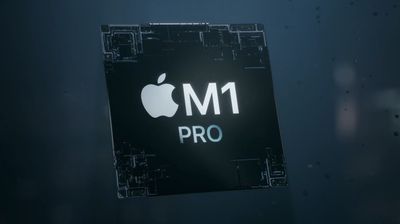
When choosing your M1 Pro MacBook Pro configuration, should you upgrade to the 32GB memory option and does it justify its cost? Our guide helps to answer the question of how to decide which of these two memory options for the high-end MacBook Pro is best for you.
Unified Memory Architecture
Macs and PCs have traditionally needed to use multiple chips for the CPU, RAM, I/O, and more. With Apple silicon chips, these technologies are combined into a single System on Chip (SoC), delivering a new level of integration for improved performance and power efficiency.

Like the M1 chip, the M1 Pro features a unified memory architecture. This brings together high-bandwidth, low-latency memory into a single pool within a custom package. This allows all of the technologies in the SoC to access the same data without copying it between multiple pools of memory, which significantly improves performance and efficiency.
The MacBook Pro's substantially different memory hardware is the basis for its improved memory performance, but the M1 Pro MacBook Pro is also bolstered by 200GB/s unified memory and a faster, 7.4GB/s SSD, which means that the memory is much quicker and the system can swap with the SSD faster. Overall, this means that the new MacBook Pro's memory performance is massively improved compared to previous MacBook Pro models, as well as most PCs.
Decisions about getting either 16GB or 32GB of memory should therefore be rooted in the understanding that the MacBook Pro's memory is not conventional RAM, but rather a much faster unified memory architecture.
macOS Optimization
macOS intelligently optimizes memory usage in the background, filling up much of the available RAM for better performance. This means that high memory usage does not necessarily indicate that you need additional memory.
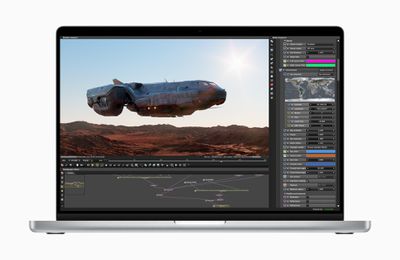
Using the faster SSD in the high-end MacBook Pro, the system can also swap data on the memory with the SSD if it needs to do so. As evidenced by the performance of previous Apple silicon Macs, macOS is able to optimize the unified memory pool extremely well. As a result, the extent and effectiveness of macOS optimization should be factored into decisions about paying for the $400 32GB memory upgrade.
Real-World Tests
The YouTube channel Max Tech recently compared the 16GB and 32GB MacBook Pro models when performing a number of intense tasks to give an indication of how the two memory configurations weigh up.
In Lightroom Classic, Max Tech found that the 32GB MacBook Pro performed exports just two seconds faster than the 16GB model. With multiple memory-hungry applications open in the background, the gap between the machines only increased by one second.
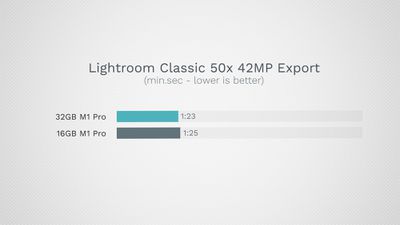
When exporting 4K ProRes RAW video, the 16GB MacBook Pro was just six seconds slower than the 32GB version. When exporting 8K ProRes RAW video, this gap reduced to just a single second.
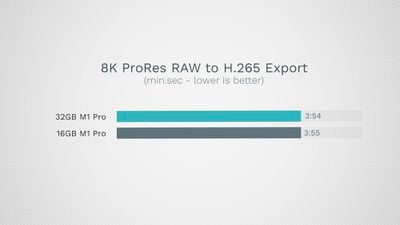
In Xcode, the 16GB model compiled a project in 137 seconds, compared to the 32GB model's 115 seconds. When performing photo editing, video editing, audio editing, coding, and heavy browsing, the 32GB model did not substantially outperform the 16GB model.
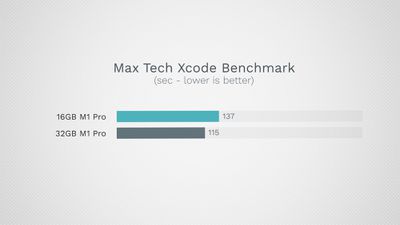
Max Tech did not notice any tangible slowdowns on the 16GB model, even when simultaneously running large and resource-heavy Logic Pro X and Final Cut Pro X projects. The narrowness of the difference between the two models was shown in practice when the 16GB model did not noticeably need to reload browser tabs more often than the 32GB model, despite a large number of intense tasks being active in the background.
We did our own memory test, comparing the base 14-inch MacBook Pro, which has 16GB RAM, with the high-end 16-inch MacBook Pro equipped with 32GB RAM. This was a real-world memory test, so we loaded up a series of apps that one might use in a video editing workflow, like Final Cut Pro, Lightroom, Chrome, Safari, Music, and a few others, and there were zero performance hiccups with either machine, with the 16GB MacBook Pro performing as well as the higher-end model.
Final Thoughts
Unless you are configuring your MacBook Pro with the M1 Max chip, which starts with 32GB of memory, you likely do not need the $400 add-on. In real-world tests, the 32GB MacBook Pro is not significantly outperforming the 16GB model, even during intense workflows.
Memory is often the limiting factor for older workstations, leading some observers to claim that upgrading to more memory is a worthwhile investment in terms of futureproofing. It should be remembered that other parts of the machine will inevitably age over time, so it is up to you if you feel the $400 upgrade is worthwhile for potential futureproofing. Alternatively, this money could be saved to spend on a future machine instead.
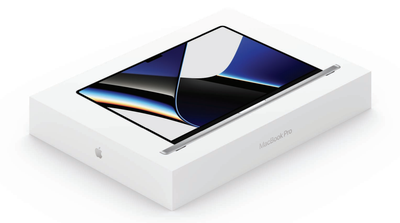
Apple's unified memory architecture and excellent memory management in macOS appears to be getting much more out of its memory compared to machines that do not have an Apple silicon SoC. The high-end 14 and 16-inch MacBook Pro models benefit from much faster SSD and memory, enabling them to swap memory even faster. This is the basis for the excellent memory performance of the 16GB model and why it should suffice for most users.
Moreover, it is important to understand that intense tasks often also heavily rely on the CPU or GPU. This means that memory is not always the choke-point for performance lag. You may max out other hardware before you begin to push the limits of the unified memory, resulting in slowdowns regardless of the amount of memory you have.
Generally, if you need 32GB of memory, you will know that you need it for extremely intense workflows such as running virtual machines or heavy video editing with multiple 4K or 8K streams. That being said, most customers with workflows of sufficient intensity to warrant 32GB of RAM will opt for the M1 Max chip over the M1 Pro.
Related Stories
M1 Pro vs. M1 Max Buyer's Guide
Apple recently announced a major update for its high-end MacBook Pros, with the new machines featuring a complete redesign, larger mini-LED displays with ProMotion, an HDMI port and SD card slot, full-sized function keys, and more. The new machines contain one of two all-new scaled-up variants of the M1 System on Chip (SoC), the M1 Pro or the M1 Max. Subscribe to the MacRumors YouTube channel ...
13-Inch MacBook Pro vs. 14- and 16-Inch MacBook Pro Buyer's Guide
Apple recently announced a major update for its high-end MacBook Pro models, with the new machines featuring a complete redesign, the M1 Pro and M1 Max chips, larger mini-LED displays with ProMotion, an HDMI port and SD card slot, full-sized function keys, and more. Subscribe to the MacRumors YouTube channel for more videos. In November 2020, Apple updated its popular 13-inch MacBook Pro...
14-Inch MacBook Pro vs. 16-Inch MacBook Pro Buyer's Guide
Apple recently announced a major update for its high-end MacBook Pro models, with the new machines featuring a complete redesign, the M1 Pro and M1 Max chips, larger mini-LED displays with ProMotion, an HDMI port and SD card slot, full-sized function keys, and more. The redesigned MacBook Pro is available in all-new 14-inch and 16-inch sizes. Despite both being high-end models, the 14- and...
Apple's M1 Pro Chip: Everything You Need to Know
Friday October 29, 2021 1:13 pm PDT by Juli Clover
Apple in October 2021 introduced its second-generation Apple silicon chips, the M1 Pro and the M1 Max, which follow the M1 and are available in the 14 and 16-inch MacBook Pro models. This guide focuses on the M1 Pro, which is an improvement over the M1, but not quite as powerful as the M1 Max. M1 Pro Explained The M1 Pro is Apple's second System on a Chip (SoC) developed for use in Macs, ...
Apple's M1 Max Chip: Everything You Need to Know
Friday October 29, 2021 1:13 pm PDT by Juli Clover
Apple in October 2021 introduced its second-generation Apple silicon chips, the M1 Pro and the M1 Max, which follow the M1 and are available in the 14 and 16-inch MacBook Pro models. This guide focuses on the M1 Max, which is Apple's most powerful Apple silicon chip to date. M1 Max Explained The M1 Max, along with the M1 Pro, is Apple's second System on a Chip (SoC) developed for use in...
What to Expect From October 18 'Unleashed' Apple Event: New MacBook Pros, AirPods 3 and More
Friday October 15, 2021 2:10 pm PDT by Juli Clover
Apple's first fall event of 2021 focused on the iPhone and the Apple Watch, but the second, set to be held on Monday, October 18, is expected to be Mac-centric. The upcoming event will see the debut of the highly anticipated 14 and 16-inch MacBook Pro models, plus we could also get refreshed AirPods and a new Mac mini. Subscribe to the MacRumors YouTube channel for more videos. This guide...
Apple M1X Chip Rumor Archive
Tuesday October 12, 2021 1:44 pm PDT by Juli Clover
The M1X was one of the rumored names for the Apple silicon chips that followed the M1. These chips actually turned out to be called the M1 Pro and the M1 Max, and Apple did not use the "M1X" nomenclature. Though the naming was wrong, the rumors about the chip were accurate, and this guide serves as an archive for all of the rumors about the M1X prior to the launch of the new MacBook Pro...
Apple's 2022 MacBook Air: Everything We Know
Monday November 8, 2021 2:52 pm PST by Juli Clover
The next-generation MacBook Air refresh coming in 2022 will see Apple introduce the biggest design update to the MacBook Air since 2010, which is when Apple introduced both 11 and 13-inch models. We're expecting a total overhaul of the look of the machine, and this guide aggregates all of the rumors that we've heard so far. Subscribe to the MacRumors YouTube channel for more videos. Design ...
Popular Stories
Apple CEO Tim Cook 'Secretly' Signed $275 Billion Deal With China in 2016
Apple CEO Tim Cook "secretly" signed an agreement worth more than $275 billion with Chinese officials, promising that Apple would help to develop China's economy and technological capabilities, The Information reports. In an extensive paywalled report based on interviews and purported internal Apple documents, The Information revealed that Tim Cook personally forged a five-year agreement...
iPhone 14 Pro Models to Feature Hole-Punch Display
Wednesday December 8, 2021 3:40 pm PST by Juli Clover
The high-end iPhone 14 Pro models launching in 2022 are expected to have a hole-punch display, according to Korean website The Elec. The 6.1-inch iPhone 14 Pro and a 6.7-inch iPhone 14 Pro Max are expected to feature the upgraded display, which will do away with the notch used in the current iPhone models. The hole-punch cutout will allow Apple to provide a larger display area while still...
iOS 15.2 Adds 'Parts and Service History' Feature to iPhone
Tuesday December 7, 2021 9:12 pm PST by Juli Clover
With the launch of iOS 15.2, Apple is adding a new "Parts and Service History" section to the Settings app that will let users see the service history of their iPhones and confirm that components used for repairs are genuine. As outlined in a new support document, iPhone users who have iOS 15.2 or later installed can go to Settings > General > About to access Parts and Service History. The...
Apple Music Voice Plan Coming in iOS 15.2
Tuesday December 7, 2021 10:25 am PST by Juli Clover
Apple today provided the release candidate version of iOS 15.2 to developers for testing purposes, and in the release notes, Apple says that the new Apple Music Voice Plan is set to launch alongside the update. Introduced in October, the Voice Plan is a new tier for Apple Music that is priced more affordably than a standard Apple Music plan. It's $4.99 instead of $9.99, and is designed...
macOS Monterey 12.1 Fixes Major Tap to Click, YouTube HDR, and Charging Bugs
Tuesday December 7, 2021 10:48 am PST by Juli Clover
macOS Monterey 12.1, which is set to be released to the public in the near future, addresses several significant bugs that Mac users have been complaining about for weeks. According to Apple's release notes, it fixes a bug that could cause the trackpad to become unresponsive to taps or clicks. We reported on the Tap to Click bug earlier this month after receiving dozens of complaints from Mac...
Kuo: AirPods Pro 2 With New Design and Improved Chip to Launch in Late 2022
Wednesday December 8, 2021 12:11 am PST by Sami Fathi
The AirPods Pro 2, the first update to the AirPods Pro since they debuted in 2019, will launch in the fourth quarter of 2022, according to Apple analyst Ming Chi-Kuo. In a note obtained today by MacRumors, Kuo said that the second generation AirPods Pro will launch in the last quarter of 2022. Prior reports have indicated that the AirPods are going to launch next year, but excluding one...
Apple Giving Customers a Second Chance to Buy AppleCare+ After Their iPhone or Mac is Repaired
Wednesday December 8, 2021 7:56 am PST by Joe Rossignol
Apple is now providing customers who have faced a costly out-of-pocket repair for an iPhone or Mac with a second chance to purchase AppleCare+ coverage for the device, although there are some strings attached to the policy. In an internal memo this week, obtained by MacRumors, Apple said customers who had an iPhone or Mac repaired at an Apple Store or Apple Authorized Service Provider are...
Report: iOS Users Who Opt-Out of App Tracking Continue to Be Tracked by Facebook and Snapchat
"Loose" interpretations of Apple's privacy policies allow apps such as Facebook and Snapchat to continue tracking users for targeted advertising even when they have asked to not be tracked, The Financial Times reports. In May, Apple launched its App Tracking Transparency feature that allows users to opt-out of being tracked across apps and websites for advertising purposes. Seven months...
Apple Updates AirPods, AirPods Pro, and AirPods Max Firmware
Thursday December 9, 2021 11:16 am PST by Juli Clover
Apple today released a new 4C165 firmware update for the AirPods 2, AirPods 3, AirPods Pro, and AirPods Max. The second-generation AirPods and AirPods Max were previously running firmware version 4A400. The AirPods Pro previously had 4A402 firmware available, and AirPods 3 were running firmware version 4B66. Apple does not offer information on what's included in refreshed firmware updates...
How To Upgrade 16gb Iphone To 32gb
Source: https://www.macrumors.com/guide/16gb-vs-32gb-macbook-pro/
Posted by: vanmetersamintme.blogspot.com

0 Response to "How To Upgrade 16gb Iphone To 32gb"
Post a Comment